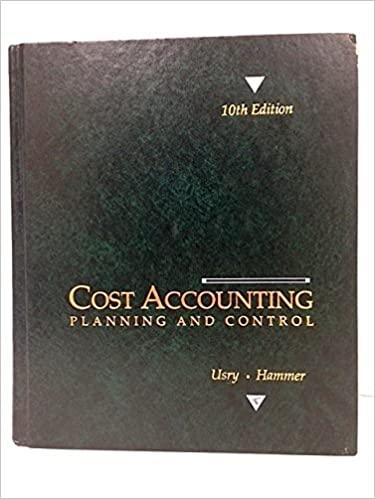Question
Peter Johnson and Lily Brown own JB Manufacturing Company (JB). JB produced storage sheds in three primary models (A, B, and C). The industry was
Peter Johnson and Lily Brown own JB Manufacturing Company (JB). JB produced storage sheds in three primary models (A, B, and C). The industry was dominated by Coleman, Phoenix, and Meco, which made several of types of sheds. JB was a small player in the industry with a solid customer base and a profitable business over last few years. This year was a little different their profit was significantly lower than the prior years. The companys 2017 financials are provided in Exhibit 1. The company produces 3 products lets call them Shed A, B and C for simplicity. The standard costs for these three products are provided in Exhibit 2. The Selling, general, and administrative (SG&A), other costs, interest income, and interest expense are likely to remain the same no matter which product-line combinations the company produced. The company is thinking about the future and has provided a preliminary proforma 2018 sales budget in Exhibit 3. Favorable preliminary 2018 forecasts lead management to believe there will be excess cash flow in 2018. Management has requested that a consultant be hired to provide an analysis of several proposed 2018 investments. The details of the proposed investments are provided in Exhibit 4. The company hires your services as their consultant. They believe that they can improve their bottom-line (net profits) by changing the product mix, pricing and advertising decisions.
?? Prepare a purchases and cash receipts budget for September, October, and November using the 2018 sales budget provided in Exhibit 3.??
Exhibit 1
| Sales | 38,650,000 |
| minus cost of products sold | 21,150,000 |
| Gross Margin | 17,500,000 |
| SG&A | 9,350,000 |
| Other Costs | 2,100,000 |
| Operating Income | 6,050,000 |
| Minus Interest Expense | 420,000 |
| Plus Interest Income | 150,000 |
| Income Before Tax | 5,780,000 |
| Income Taxes | 2,023,000 |
| Net Income | 3,757,000 |
Exhibit 2
| Shed A | Shed B | Shed C | Notes | |
| Planned Units | 75,000 | 100,000 | 205,000 | |
| Price per unit | $150 | $110 | $80 | |
| Direct Costs: | ||||
| Materials | $17 | $10 | $7 | directly related to volume |
| Labor | $21 | $16 | $4 | directly related to volume |
| Subtotal | $38 | $26 | $11 | |
| Indirect Costs: | ||||
| Supplies | $7 | $2 | $1 | directly related to volume |
| Labor | $10 | $8 | $4 | 50% variable, 50% fixed |
| Energy | $12 | $6 | $4 | 50% variable, 50% fixed |
| Supervision | $8 | $3 | $1 | unrelated to volume |
| Depreciation | $22 | $7 | $5 | unrelated to volume |
| Accounting/Legal/IT | $12 | $6 | $3 | unrelated to volume |
| Other Fixed Costs | $11 | $2 | $1 | unrelated to volume |
| Subtotal | $82 | $34 | $19 | |
| Total Costs | $120 | $60 | $30 | |
| Profitability | $30 | $50 | $50 |
| Exhibit 3 | Proforma Sales Budget 2018 | |||||||||||||||||||||||||||||||||||||||||||||||
| Month | Budgeted Cash Sales | Budgeted Credit Sales | Total Budgeted | |||||||||||||||||||||||||||||||||||||||||||||
| January | $900,000 | $2,100,000 | $3,000,000 | |||||||||||||||||||||||||||||||||||||||||||||
| February | $900,000 | $2,100,000 | $3,000,000 | |||||||||||||||||||||||||||||||||||||||||||||
| March | $900,000 | $2,100,000 | $3,000,000 | |||||||||||||||||||||||||||||||||||||||||||||
| April | $900,000 | $2,100,000 | $3,000,000 | |||||||||||||||||||||||||||||||||||||||||||||
| May | $900,000 | $2,100,000 | $3,000,000 | |||||||||||||||||||||||||||||||||||||||||||||
| June | $900,000 | $2,100,000 | $3,000,000 | |||||||||||||||||||||||||||||||||||||||||||||
| July | $900,000 | $2,100,000 | $3,000,000 | |||||||||||||||||||||||||||||||||||||||||||||
| August | $930,000 | $2,170,000 | $3,100,000 | |||||||||||||||||||||||||||||||||||||||||||||
| September | $960,000 | $2,240,000 | $3,200,000 | |||||||||||||||||||||||||||||||||||||||||||||
| October | $870,000 | $2,030,000 | $2,900,000 | |||||||||||||||||||||||||||||||||||||||||||||
| November | $1,140,000 | $2,660,000 | $3,800,000 | |||||||||||||||||||||||||||||||||||||||||||||
| December | $1,080,000 | $2,520,000 | $3,600,000 | |||||||||||||||||||||||||||||||||||||||||||||
| $11,280,000 | $26,320,000 | $37,600,000 | ||||||||||||||||||||||||||||||||||||||||||||||
| The gross profit rate is 55% and the desired inventory level is 30% of next month's cost of sales. | ||||||||||||||||||||||||||||||||||||||||||||||||
| Management estimates that 5% of credit sales are not collectible. | ||||||||||||||||||||||||||||||||||||||||||||||||
| Of the credit sales that are collectible, 60% are collected in the month of sale and the remainder in the month following the sale. | ||||||||||||||||||||||||||||||||||||||||||||||||
| Cost of purchases of inventory each month is 70% of the next month's projected total sales. | ||||||||||||||||||||||||||||||||||||||||||||||||
| All purchases of inventory are on account; 25% are paid in the month of purchase, and the remainder is paid in the month following the purchase.
| ||||||||||||||||||||||||||||||||||||||||||||||||
Step by Step Solution
There are 3 Steps involved in it
Step: 1

Get Instant Access to Expert-Tailored Solutions
See step-by-step solutions with expert insights and AI powered tools for academic success
Step: 2

Step: 3

Ace Your Homework with AI
Get the answers you need in no time with our AI-driven, step-by-step assistance
Get Started


